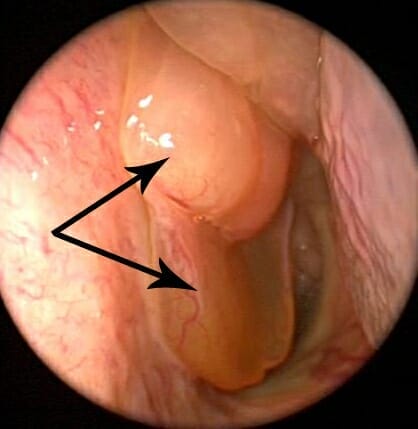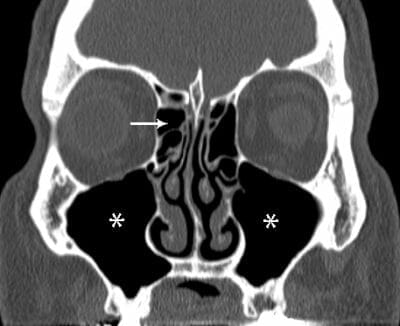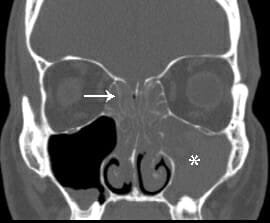Introduction
“Sinusitis”, “rhinosinusitis” and “sinus infection” are terms that are commonly used by patients, healthcare providers, and the media. However, accurately diagnosing sinusitis is often more complicated than people realize. A number of factors are considered when making a diagnosis of sinusitis. These include a patient’s symptoms, the duration of the symptoms, examination findings and, if needed, the results of testing.
Symptoms
Sinusitis, or rhinosinusitis, results from inflammation of the lining of the nasal passages and paranasal sinuses. The paranasal sinuses are air spaces that fill your cheeks, forehead, and areas between your eyes (See Sinus Anatomy). While the bones of the face and forehead may feel solid, they are actually hollow. The hollows spaces are the sinuses. Sinus “inflammation” refers to irritation and swelling of the lining of the sinuses.
Some symptoms are very common with sinusitis. Other symptoms occur less frequently. Many symptoms that occur with sinusitis or sinus infections may also be seen with other conditions. For example, the common cold or nasal allergies can cause similar symptoms. This may result in confusion when determining the cause of your symptoms. Your Otolaryngologist (ENT physician) can help you identify the correct diagnosis and determine the best treatment for your condition.
Since many of these symptoms may overlap with other nasal and sinus conditions, the timing, combination of symptoms, and other tests can often help to find the correct diagnosis for your problem.
Time Course
Less than 10 days
Inflammation of the sinuses that is present for less than 10 days is usually due to a viral infection. This is also known as a viral upper respiratory infection (URI), or the common cold. Some symptoms commonly occur with viral URI, but are less likely with bacterial sinus infections. These include fatigue, sore throat, and muscle aches. Because the common cold is caused by a virus, antibiotics are not recommended. Antibiotics do not stop viruses from growing or speed the recovery from a virus. Typical treatment for the common cold includes rest and drinking plenty of fluids. Over-the-counter medications may also be recommended by your physician to lesson your symptoms.
We are exposed to airborne viruses frequently. Healthy adults may get a few viral infections each year. Children average about 6 episodes of the common cold each year, until their immune system gets stronger. Adults exposed to young children often have more viral infections than those who are not.
More than 10 days
Symptoms present for more than 10 days without improvement may be due to an acute bacterial sinus infection. A bacterial infection is also suspected if symptoms seem to worsen after about 5 days. This may occur following a cold or during a particularly bad allergy season. It is important to make this diagnosis because antibiotics can speed recovery from bacterial sinusitis.
More than a few months
If your symptoms have been going on for longer than 3 months, you may have chronic sinusitis. Symptoms of chronic sinusitis may be worse at some times than others, but are always present. To confirm the diagnosis of chronic rhinosinusitis, an ENT physician typically examines the nasal cavity with a simple procedure called endoscopy, or obtains a CT scan. In chronic sinusitis, infection is NOT typically the cause of the inflammation. Asthma may also accompany chronic sinusitis.
Tests Used to Diagnose Sinusitis
Nasal endoscopy
When visiting your Otolaryngologist, it may be recommended that you undergo a “nasal endoscopy”. This is a procedure performed in the physician’s office while you are awake. No sedation or general anesthesia is needed for the procedure. Typically, a spray will be applied to your nose to make the endoscopy more comfortable. The spray usually contains a decongestant and a topical anesthetic medication. The decongestant helps to shrink the nasal lining to allow the scope to pass more easily. The anesthetic numbs your nasal lining.
A nasal endoscope both provides light and magnifies the image of the nasal cavity. Your ENT will examine the anatomy of your nose. He or she will also identify signs of inflammation and infection. If infection is present your ENT may use the nasal endoscope to take cultures of the drainage that is present. Cultures can help your physician choose the best antibiotic to treat your sinus infection. Cultures taken at random from the front of the nose or from blowing the nose are not reliable. Nasal endoscopy may also identify any concerning growths or lesions. If necessary, biopsies can also be performed during nasal endoscopy.

Radiologic Studies
X-ray
Plain X-rays are no longer routinely performed to help in diagnosing sinusitis. Currently, a CT (CAT) scan is the study of choice for imaging the sinuses.
CT scan
Usually, CT scans are not performed for the initial diagnosis or treatment of sinusitis. However, your physician may recommend a CT scan of the sinuses in certain cases. If the diagnosis of sinusitis is unclear, a CT may be ordered to help guide your treatment. Because many diagnoses can mimic sinusitis, a CT scan that shows no sinusitis is still valuable. A “negative” or “clear” sinus CT scan allows the physician to consider other causes of your symptoms. If you are still having symptoms after treatment of chronic sinusitis, it is common to obtain a CT scan. This CT scan helps the physician determine if additional medical treatment or surgery is recommended. Finally, if more serious complications of sinusitis are suspected, a CT scan may be obtained. Rare complications include spread of infection to the eyes or brain. MRI scans are not typically ordered for sinusitis, but may be helpful for these complications.


Limitations of radiographic studies
While CT scans can be helpful, any radiologic study is simply a picture taken at one point in time. Symptoms can change over time, and this may lead your physician to recommend additional studies at a later time. A sinus CT carries a small risk from radiation exposure. A CT should only be obtained if (1) the results will change your treatment, (2) sinus surgery is being considered, or (3) if the sinusitis is causing a complication. In addition, a CT scan cannot distinguish between a viral URI and bacterial sinusitis. For this reason, the diagnosis and treatment of early infections are typically based on symptoms and time course, rather than imaging studies.
Other Diseases That May Mimic Sinusitis
Viral Upper Respiratory Infection (URI) or Common Cold
While many of the symptoms of a viral cold are the same as bacterial sinusitis, these conditions are treated differently. See the section above entitled Time Course – Less than 10 days.
Environmental Allergies
The symptoms of environmental allergies and sinusitis overlap to some degree. Additionally, some patients may have both allergies and sinusitis. Symptoms that are more common with environmental allergies include sneezing, clear nasal drainage, itchy nose or throat, itchy watery eyes, itchy skin, and eczema. In addition, allergy symptoms tend to fluctuate with the seasons or with a change in your environment. Most people with allergies will notice specific triggers for their symptoms. Triggers may include increases in pollen counts, freshly cut grass, cats or dogs.
Headaches
“Sinus headache” is a common term, but can be misleading. Facial pain/pressure or headache that occurs without nasal congestion or discolored drainage is only rarely caused by sinusitis. There are many causes of headaches and facial pain. These include migraine headaches, tension headaches, temporomandibular joint (TMJ or jaw joint) problems, and dental issues. Rarer causes of headache are tumors of the sinuses and brain. Your physician can help you determine the most likely source of your headache.
Acid Reflux
Acid reflux occurs when stomach acid comes up to irritate the esophagus or throat. Acid reflux may contribute to a number of symptoms that are commonly associated with sinusitis. These include thick phlegm in the throat, post-nasal drainage, chronic throat clearing, and intermittent voice changes. Acid reflux is treated differently than sinusitis. It is therefore important to make the correct diagnosis.
More Serious Concerns Related To Sinus Infections
In rare cases, sinus infections may spread outside the sinus cavities (See Complications Of Sinusitis). The eyes and brain are located close to the sinus cavities. These structures may be involved with sinus infections in very rare cases. If you experience any of the symptoms below in association with a sinus infection, you should seek medical attention immediately:
- Severe headache
- Stiff neck
- Confusion
- High fever
- Vision changes
- Swelling or redness of the eye or eyelids
Treatment
Treatment options for rhinosinusitis include nasal sprays, nasal irrigations, antibiotics, oral medications for allergies and inflammation, and sometimes surgery of your nasal cavity and sinuses. Treatment will be determined based on your specific symptoms, the duration of your sinusitis, your other medical problems, and your exam and imaging findings. Your ENT will consider these factors when making a diagnosis and determining the best treatment for you.
Summary
We have discussed the most common symptoms, time course, and diagnostic tests for sinusitis. However, please remember that every patient is different. Sinus infections do not always follow the typical symptom presentation or course. Please consult with your physician about your individual sinus concerns.
Copyright © 2020 by the American Rhinologic Society

